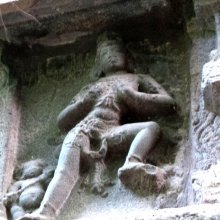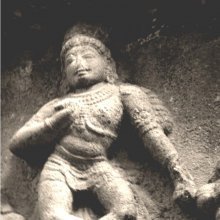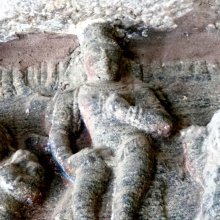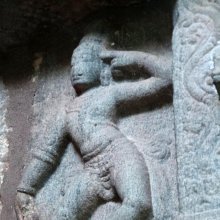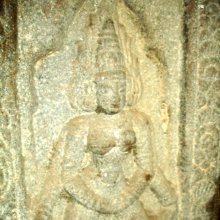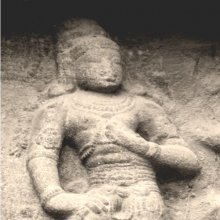Dolapada, Dolāpāda, Dola-pada: 4 definitions
Introduction:
Dolapada means something in Hinduism, Sanskrit. If you want to know the exact meaning, history, etymology or English translation of this term then check out the descriptions on this page. Add your comment or reference to a book if you want to contribute to this summary article.
Images (photo gallery)
In Hinduism
Natyashastra (theatrics and dramaturgy)
Source: Wisdom Library: Nāṭya-śāstra1) Dolāpāda (दोलापाद).—One of the 108 karaṇas (minor dance movement) mentioned in the Nāṭyaśāstra chapter 4. The instructions for this dolāpāda-karaṇa is as follows, “the Kuñcita feet thrown up, and two hands swinging from side to side in a manner befitting the dance.”.
A karaṇa represents a minor dance movements and combines sthāna (standing position), cārī (foot and leg movement) and nṛttahasta (hands in dancing position).
2) Dolāpādā (दोलापादा) refers to a one of the thirty-two cārīs, according to the Nāṭyaśāstra chapter 11. The Dolāpādā-cārī is classified as a ākāśikī, or “aerial”, of which there are sixteen in total. The term cārī refers to a “dance-step” and refers to the simultaneous movement of the feet (pāda), shanks (jaṅghā) and the hip (ūru). From these cārīs proceed dance as well as movements in general.
Source: archive.org: Natya ShastraDolapādā (दोलपादा).—A type of aerial (ākāśikī) dance-step (cārī);—Instructions: one Kuñcita foot thrown up and moved from side to side and then caused to fall on the ground as an Añcita foot.
Source: Shodhganga: Elements of Art and Architecture in the Trtiyakhanda of the Visnudharmottarapurana (natya)Dolāpāda (दोलापाद) [mentioned twice] refers to one of the 108 kinds of Karaṇa (“coordination of precise movements of legs and hands”), according to the Viṣṇudharmottarapurāṇa, an ancient Sanskrit text which (being encyclopedic in nature) deals with a variety of cultural topics such as arts, architecture, music, grammar and astronomy.—According to the Viṣṇudharmottarapurāṇa, karaṇas are the coordination of precise movements of legs and hands performed in a particular posture. The Nāṭyaśāstra also gives its view point in the same spirit. In the Viṣṇudharmottarapurāṇa, one hundred and eight kinds of karaṇas are accepted, e.g., Dolāpāda.

Natyashastra (नाट्यशास्त्र, nāṭyaśāstra) refers to both the ancient Indian tradition (shastra) of performing arts, (natya—theatrics, drama, dance, music), as well as the name of a Sanskrit work dealing with these subjects. It also teaches the rules for composing Dramatic plays (nataka), construction and performance of Theater, and Poetic works (kavya).
Languages of India and abroad
Kannada-English dictionary
Source: Alar: Kannada-English corpusḌōlapāda (ಡೋಲಪಾದ):—
1) [noun] (dance.) a movement in which one leg, that is slightly bent, is lifted up and moved from side to side swinging and the heel is kept on the ground on its side.
2) [noun] (dance.) a moving of one leg, thigh raised up, shank bent, and both hands hung on their natural position without bending the fingers.
Kannada is a Dravidian language (as opposed to the Indo-European language family) mainly spoken in the southwestern region of India.
See also (Relevant definitions)
Partial matches: Dola, Pada, Pata, Tola.
Ends with: Gandolapada, Kandolapada.
Full-text: Gajakridita, Talasamghattita, Prenkholita, Skhalita, Carin.
Relevant text
Search found 3 books and stories containing Dolapada, Dolāpāda, Dola-pada, Dolā-pāda, Dolāpādā, Dolapādā, Ḍōlapāda; (plurals include: Dolapadas, Dolāpādas, padas, pādas, Dolāpādās, Dolapādās, Ḍōlapādas). You can also click to the full overview containing English textual excerpts. Below are direct links for the most relevant articles:
Vishnudharmottara Purana (Art and Architecture) (by Bhagyashree Sarma)
2.5. Karaṇa (movements of legs and hands) < [Chapter 3 - Drama and Dance]
Natyashastra (English) (by Bharata-muni)
Yaksha Gana < [September-October 1934]
